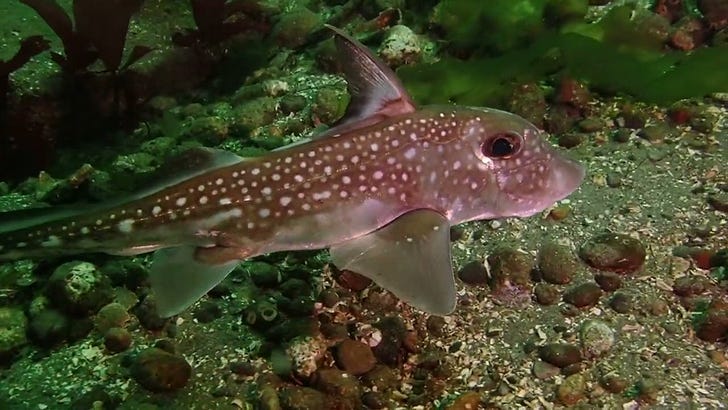I’m Not a Rodent
Today’s special animal friend is the spotted ratfish, Hydrolagus colliei, a cartilaginous fish found in the northeastern Pacific Ocean. It’s only a coincidence that this is the same habitat as the black rockfish. When I started reading about the rockfish, Son F said, “Ratfish?” and I said, “There probably is one,” and sure enough. The name comes from their long, skinny tail, which is a fishy tail, sort of like a ray’s, and not a rat-like tail. The tail doesn’t help with propulsion: this fish, like a ray, moves by fluttering its wide, wing-like pectoral fins.
The spotted ratfish has smooth, scaleless, brownish skin with sparkles of blue, green, and gold and a festive scattering of white dots on the back. Females can be 39” long; males are about 24”. Their fins are translucent and give them a ghostly appearance, making them less visible to predators. The leading edge of the dorsal fin is a venomous spine. I looked for information on the composition of the venom, but I didn’t find anything. It is said to be very painful for humans, but not otherwise very harmful.
The spines have been found in the flesh of seals and sea lions. If this deterred the mammalian predators, they were lucky: when they swallow the ratfish, the spine can perforate their esophagus or stomach and kill them. Other predators of spotted ratfish include sablefish, sharks, sea birds, and Humboldt squid.
Spotted ratfish have two teeth in the bottom jaw and four in the top jaw. They use these to grasp crustaceans, clams, and other bottom-dwelling shellfish, crunching them up with extremely powerful jaws and grinding away with the mineralized teeth. Sometimes the prey turns the tables. Here is a Velcro Star, Stylasterias forreri, getting a fishy meal:
The Velcro star, a five-armed sea star with many very sharp pincers, can be 40” across. I could do a major digression on sea stars, but let’s get back to the ratfish. Like other cartilaginous fish, ratfish reproduce with internal fertilization. Males have two “claspers” in their pelvic area which they use, one at a time, to deposit sperm into a female’s two oviducts. Males also have tentacula, “stalked club structures with little hooks,” one on the forehead and two more in front of the pelvic fins. They extrude these and use them to hold on to the females during copulation.
Eventually, the female will produce egg cases: two at a time, one from each oviduct. Each one contains a single egg. They may hang from the female’s body for several days before dropping off. A week or more later, she will produce two more. The cases fall to the seafloor and take five to ten months to hatch. It probably depends on water temperature. The baby ratfish are about 5” long when they emerge from the case. If they survive their first year, they reach 12” in length and are likely to live many more years. It is believed that they have quite a long lifespan: females are not reproductively mature until they are 14 years old. They can reproduce throughout the year.
Spotted ratfish are a species of Least Concern. They are not commercially or recreationally fished, although they are sometimes brought up with other species in nets. They are adaptable, surviving in the ocean from Baja California to Alaska and at depths from 100 feet to 3,000 feet. They are successfully kept in many aquariums in Pacific Coast states.



Good morning, everyone. I slept late.
Placido Domingo, everyone!